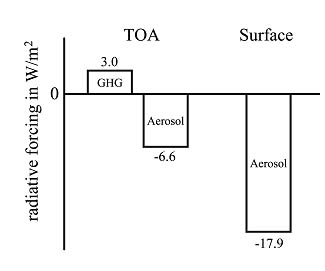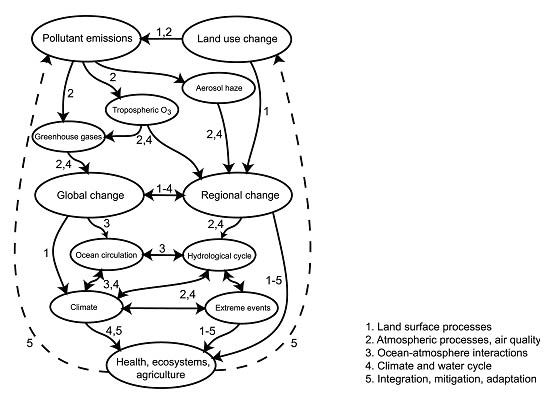
Jos Lelieveld(1) and Nikos Mihalopoulos(2)
(1)Max Planck Institute for Chemistry
P.O. Box 3060, D-55020 Mainz
Germany
(2)Environmental Chemical Processes Laboratory
University of Crete
Heraklion
Greece.
Extended abstract
1. Introduction
In the Mediterranean Intensive Oxidant Study (MINOS) an international team of
scientists from eight countries has investigated the Mediterranean atmosphere
during six weeks in July-August 2001. Measurements of the chemical composition
and the radiation budget of the Mediterranean troposphere were performed both
from a ground-station and with the use of aircraft. The objective was to study
long-distance transport of natural and anthropogenic trace gases and aerosols
and their effects on air quality and climate. The results indicate that anthropogenic
emissions cause a large-scale air quality decrease and may contribute to a reduction
of precipitation.
The operational base of MINOS was Crete, where a monitoring station was equipped to measure a large number of gaseous and particulate air constituents as well as solar radiation scattering and absorption. Measurement details are provided through the following website, which includes a link to the MINOS special issue of the online journal Atmospheric Chemistry and Physics: http://www.mpch-mainz.mpg.de/~reus/minos/. The measurement campaign was hosted by the University of Crete in Heraklion. Two aircraft, a twinjet Falcon and a King Air, performed more than 20 research flights to sample the air over the Mediterranean Sea (Lelieveld et al. 2002).
2. Air pollution “crossroads”
The measurements give evidence of a remarkably high level of air pollution from
the surface to the top of the troposphere up to15 km altitude. The strongest
anthropogenic influence was observed in the lower 4 km, originating from both
West and East Europe transported by the northerly flow. The sources are industrial
activity, traffic, forest fires, agricultural and domestic burning. An abundance
of burning effluents from the region north of the Black Sea was especially evident
over the eastern Mediterranean Sea biomass during the campaign. Since the Mediterranean
region has very few clouds in summer, solar radiation levels are high so that
noxious reaction products such as ozone and peroxyacetyl nitrate (PAN) are formed
in photochemical smog.
At higher altitudes, above 4 km, significant contributions from long-distance pollution transport from North America and Asia were found, for example, for carbon monoxide (CO). It is quite remarkable that about half of the mid-tropospheric CO over the Mediterranean originates from Asia and 25-30% from North America. These transports follow the prevailing westerly winds that are typical of the extra-tropics. These layers are moreover substantially affected by ozone that is mixed down from the stratosphere. It appears that the middle troposphere in particular is influenced in summer by stratosphere-troposphere exchange, leading to a stratospheric contribution to column O3 in the troposphere up to 25-30%. In addition, transport of anthropogenic O3 and its precursor gases from the USA exert a significant influence in the free troposphere.
In the upper troposphere, above 8 km altitude, another distinct layer can be distinguished, especially over the eastern Mediterranean, associated with high levels of reactive species such as formaldehyde. This is caused by anthropogenic emissions transported from South Asia, following convective lifting into the upper troposphere by thunderstorms in the Indian monsoon. Subsequently these air parcels follow the easterly tropical jet and turn north over the eastern Mediterranean in a large upper level anticyclone. The chemical “fingerprint” of biomass burning (e.g. enhanced CH3CN, CH3Cl, C2H2), in particular by biofuel use in India as also observed during the Indian Ocean Experiment, is evident. From the upper troposphere over the eastern Mediterranean these species can even penetrate the lowermost stratosphere. It appears that the Mediterranean region is a preferred location for cross-tropopause exchanges, partly related to direct convective penetration of the lower stratosphere over southern Europe.
3. Air quality and climate
Near the surface the air pollution has several undesirable consequences. First,
the European Union eight-hourly air quality standard for ozone (53 nmol/mol)
is exceeded throughout the summer in the entire Mediterranean region. High ozone
concentrations are harmful for human health and ecosystems, and they also cause
agricultural crop loss. Typical ozone mixing ratios in summer are 55-70 nmol/mol,
and the diurnal variability is small (~10%). Because the Mediterranean background
O3 levels are so high, it is difficult to control ozone in urban and industrial
areas. Second, the concentrations of aerosols are high as well, affecting human
health. The fine aerosol fraction (<1µm) is mainly composed of sulphate
(35-40%), organics (30-35%), ammonium (10-15%) and black carbon (5-10%), mostly
from fossil fuel and biomass combustion. The persistent northerly winds in summer
carry large pollution loads from Europe that can deposit onto the Mediterranean
Sea, which affects the water quality and contributes to eutrophication.
The aerosols furthermore influence the Mediterranean atmospheric energy budget by scattering and absorbing solar radiation (Figure 1). They reduce solar radiation absorption by the sea by about 10% and they alter the heating profile of the lower troposphere. As a consequence, evaporation and moisture transport, in particular to North Africa and the Middle East, are suppressed. Furthermore, satellite observations indicate important perturbations of the cloud microstructure and convection by aerosols, probably decreasing precipitation. These effects by aerosols are substantial today, even though sulphate from Europe has actually decreased in the past two decades through the abatement of acidification. Therefore, it is likely that the climate effects of the aerosols have been much larger in the past.
 |
Figure 1 - Direct radiative forcing by greenhouse gases (GHG) and aerosols over the summertime Mediterranean Sea, both for the top of the atmosphere (TOA) and at the surface. The GHG effects are based on model results, that of the aerosols on measurements during MINOS. |
The radiative forcing by aerosols also influences the energy budget of the Mediterranean Sea, of which the consequences are as yet poorly understood. The Mediterranean Sea is a small-scale ocean, which has the same phenomenology as large oceans, including a thermohaline circulation, showing signs of large perturbations in the 1990s. It is quite conceivable that the changing energy budget and anomalous winds have influenced the ocean circulation. It is conceivable that changes in evaporation, for example, owing to changes in surface heating resulting from aerosol radiative forcing, substantially influence the Mediterranean overturning. The aerosols may thus affect several components of the regional atmosphere-ocean system and the water cycle.
4. Project Mediterranean: ProMed
The atmospheric forcings to the ocean, climate and water cycle do not act in
isolation. Firstly, the regional effects are linked to large-scale phenomena
through teleconnections, for example, with the Indian monsoon and the North
Atlantic Oscillation. It is not known, however, how these system components
are linked and interact under global change. Climate change scenarios nevertheless
consistently predict further drying of the Mediterranean region, which is already
under water stress. Secondly, water availability is also determined by many
other factors, in particular agriculture. Even if the total amount of precipitation
were to remain constant, soil crust formation in dry years and heavy short-duration
rainfall in other years can have dramatic effects, as indicated by anomalous
weather events in the past decade.
Thus a wide range of environmental processes and societal conditions are in
many ways linked. The goal of ProMed is to obtain a better understanding of
these linkages, and to improve the skill to predict how the system may be affected
under climate change and human activities. The project builds upon previous
projects that have focused on system components. ProMed must bring together
the necessary information to help mitigate problems, or to adapt to them. Already
today several Mediterranean countries need to make difficult choices how to
use the limited water resources. Others have problems with their compliance
with air pollution and climate change policies, which sometimes include conflicting
directives.
• Small-scale coupled ocean-atmosphere system
• Water resources are vulnerable and under stress
• Climate change scenarios indicate further drying
• Strong influences by long-range air pollution transport
• Large perturbations of the atmospheric energy budget
• Recent changes in weather and ocean circulation
• Environmental changes have large-scale effects
• Collaborations with North-Africa and Middle-East needed
Table 1 – Why an integrated project for the Mediterranean region?
Table 1 summarizes several of the main arguments why an Integrated Project
is needed with a focus on the Mediterranean region. The project, which is presently
being set up, has four thematic components that primarily address biogeophysical
and -chemical processes and feedback mechanisms:
1. Land surface processes
2. Atmospheric processes and air quality
3. Ocean-atmosphere interactions
4. Climate and water cycle.
An additional component aims at:
5. Integration assessment: mitigation and adaptation.
The latter must support the development of societal strategies and policies.
Figure 2 indicates how these five thematic components are linked to investigate
the relationships between human activities, system forcings and responses. The
project furthermore includes “integrating” experiments to bring
together data from anchor stations, satellites, field measurement campaigns
and modelling.
In addition to the environmental and societal arguments, an important scientific
merit of ProMed derives from the fact that the Mediterranean Basin is an excellent
“natural laboratory” for investigating feedback mechanisms between
the atmosphere and ocean that control the hydrological cycle and climate, in
particular because the Mediterranean Sea is an “integrator” of natural
and anthropogenic changes over long time periods. The Mediterranean coupled
ocean-atmosphere system moreover responds relatively rapidly to atmospheric
forcings, so that research in this area provides clues as to how the global
climate system may respond to a changing environment.
Considering the different levels of knowledge and skills in the region, capacity building will be a prerequisite, in order to train young scientists, develop a quality assurance and control programme associated with the regional network of measurement stations, and to help answer questions of decision-makers and stakeholders. The project must moreover organize networks that further the communication between the disciplines and activities, and provide links with (inter)national meteorological and hydrological services and international programmes. Although it is a major challenge to establish integrated projects such as ProMed, it is an inevitable next step in environmental science to expand multi-disciplinary collaborations, and bring the results of atmospheric and climate change research to the regional level at which the questions are asked by science and society.

Figure 2 - Schematic representation of the system forcings and responses, and
how they are investigated in the 5 thematic components of ProMed. The dashed
lines imply mitigation-adaptation responses by society.
References
Lelieveld et al., Science, 298, 794-799, 2002